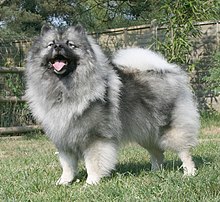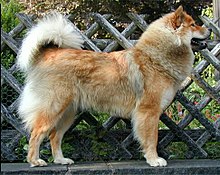
A symbol of cheerful companionship, the Keeshond is a breed that radiates warmth and friendliness. Native to the Netherlands and once the mascot of the Dutch Patriot political party, the Keeshond is distinguished by its plush two-layer coat, fox-like expression, and vivacious spirit. Their sparkling eyes and distinctive “spectacles” — markings and shading that give the appearance of glasses — add to their expressive countenance. Social and intelligent, the Keeshond is not just a wonderful family companion but also an astute watchdog, always alert to the comings and goings of their home.
The Keeshond is a member of the AKC Non-Sporting Group.
Breed Characteristics
| Dog Breed | Keeshond |
| Breed Popularity (AKC) | 90 |
| Country of Origin | Netherlands |
| Personality | Intelligent, energetic, playful, good-natured |
| Life Expectancy | 12-15 yrs |
| Height | 17-18 in |
| Weight | 35-45 lbs |
| Color | Black, Cream |
| Coat | Double |
| Shedding | Seasonal |
| Grooming | 2-3 Times a Week Brushing |
| Health Problems | Dental problems, eye issues, skin allergies |
| Trainability | Easy Training |
| Exercise Needs | Regular Exercise |
Keeshond History
Originating in the Netherlands, the Keeshond was known as a symbol of the Dutch Patriots Party in the 18th century. Often referred to as the ‘Dutch Barge Dog’, they were commonly seen on barges in canals, serving as companions and watchdogs. With their distinctive thick coat and fox-like expression, they are known for their friendly and alert nature.
Temperament
Keeshonds, often known as the ‘smiling Dutchman’, are friendly and outgoing. Their intelligence and eagerness to please make training a joy, though their vocal nature may need managing. They have a moderate energy level, thriving on regular play sessions. Early socialization helps in maintaining their affectionate demeanor. Their barking tendencies are quite pronounced, making them effective watchdogs. Behavior-wise, they are family-oriented and tend to form strong bonds with their human counterparts.
Remember, while breed traits provide a general idea, individual dogs can have personalities that differ from the breed standard. Always spend time getting to know the dog and ensure their needs and temperament align with your lifestyle.
Grooming Requirements
The Keeshond possesses a plush double coat that necessitates regular brushing to prevent matting and reduce shedding. Bathing them with a dog shampoo suited for thick coats helps maintain their fur’s lustrous appearance. As part of their grooming routine, nail trimming, ear cleaning, and checking the dense fur for any hidden issues are essential.
Keeshond Health
Keeshonds, living about 12-15 years, are generally healthy but can be prone to conditions like hip dysplasia and congenital heart issues. Regular health checks, vaccinations, flea prevention, and deworming are crucial. Ensuring they’re fed a nutritious dog food and monitoring for potential allergies can help maintain their plush coat and overall health.
Exercise Needs
Keeshonds possess a moderate to high energy level and require a consistent exercise routine to maintain their physical and mental well-being. Daily walks, fetch games, and agility activities can be an excellent outlet for their energy. Although they might enjoy a visit to the dog park for socialization and playtime, their thick fur and sensitive nature make them prone to overheating, so ensure exercise is adapted during warmer weather.
Training
The Keeshond, recognized by its plush double coat and fox-like expression, flourishes with consistent obedience training. Commands facilitate smooth potty training and channel their alert nature. Crate training provides a secure environment, complementing their watchdog tendencies. Addressing behavior problems, particularly related to their vocal nature, is crucial. Early socialization ensures they remain affable companions, despite their reserved nature towards strangers.
Keeshond Pictures



Related Dog Breeds
More Dog Resources
Are you thinking about getting a puppy? Make sure to check out our list of important questions to ask before you adopt a puppy.
We also have many resources to help, from naming your puppy to socialization resources and training tips.
Take me back to the Ultimate Guide to Dog Breeds



